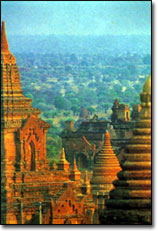|
|
|
| The many ancient pagodas of Bagan date to the 12th Century |
Myanmar, once called Burma, is one of ASEAN countries, sharing borders with Bangladesh, India, China, Laos and Thailand. With a total land area of 676, 577 sq. km, the country stretches over 2090 km from north to south and over 925 km east to west. It has a 2832 km long coastline on the Indian Ocean and over 50% of its total land area covered with forest.
Myanmar has a rich cultural and historical heritage with great places to visit like the glittering Shwedagon Pagoda in Yangon (Rangoon) and Bagan. The natural environment is equally brilliant with many parts of the country still covered in rainforest while rice paddy fields dominant much of the remainder. More than 100 different national races exhibit many unique characteristics.
Yangoon, the capital is dominated by the Shwedagon, one of the world's greatest Buddhist Pagodas built 2500 years ago. The Sule Pagoda, Bog yoke Market and the colonial buildings add to the architectural mix.
Bagan, one of Asia's is most stunning archaeological sites is located on the eastern bank of River Ayeyarwaddy. Also being the capital of first Myanmar Empire, Bagan covers an area of 42 sq. km, containing over 2000 well preserved pagodas and temples of the 11th-13th centuries and lacquerware from Bagan is keenly sought after.
Mandalay, also known as Ratanabon meaning Gem City, is located in Central Myanmar, 668 km north of Yangoon.
Mandalay Hill, 230 metres in elevation, commands a magnificent view of the city and surrounding country side. The Mandalay Palace complex was destroyed by fire during World War II. A number of palace buildings have been reconstructed within the premises as evidence of the Majestic Palace City.
Around Mandalay are Amarapura, Innwa, Sagaing, known for their ancient pagodas worth visiting. Pyin Oo Lwin, (Maymyo) is a hillstation and cool refuge from the lowland heat. Visitors can ride a stage coach, stay in Tudor style villas and enjoy the peaceful botanical gardens.
|
|
| Open air markets are colourful and plentiful in Myanmar |
Mount Popa, 50 km south east of Bagan, is 1500 m. high extinct volcano; legendary home of nat worship.
The tranquil waters of Inlay Lake is Asia's most beautiful natural lake with the famed leg rowers worth seeing and enjoying. The nearby hillstation of Kalaw offers col air and Pindaya Caves with their 10,000 Buddhist images.
Ngapali (Thandwe), Chaungtha and Ngwesaung (Pathein) are popular beaches with adventurous travelers. New potential sites are Muse, Tachilek, Kyaing Tong, Myitkyina, Putao, Kawthaung.
Ecotourism Sites
The wildlife parks and sanctuaries are Alaungdaw Kathapa National Park, Popa Mountain Park, Hlawga Wildlife Park, Shwesellaw Wildlife Sanctuary, Inlay Birds sanctuary, Mohyingyi Wetlands and Sein Ye Forest Camp.
The main gateways to Myanmar are Yangon and Mandalay International Airports. Yangon International Airport has daily flights from Bangkok and Singapore.
Overland entry points along Myanmar Thailand Border Checkpoints are at Tachileik, Myawaddy, Payathonzu (three Pagoda pass) and Kawthaung; and along Myanmar-China Border Checkpoints at Lweje, Namkham, Muse, Kyukoke, Kwanlong, Monglar.
Myanmar Culture offers unique dance, drama and puppetry. Many festivals are celebrated throughout the year. Thingyan or Water Festival ushers in the Myanmar New Year. Food is central to many festivals especially the festivities at the Pagodas. Myanmar Food is blend of several cuisines but a distinctly Myanmar Food is rice with curries, mildest among the Asians.
For more information, please visit
http://www.myanmar-tourism.com/
http://www.hotel-tourism.gov.mm
http://www.myanmar.com/Ministry/Hotel-Tour
http://www.myanmars.net/mtt
http://www.myanmartourismboard.com/
(Source: asean-tourism.com)












